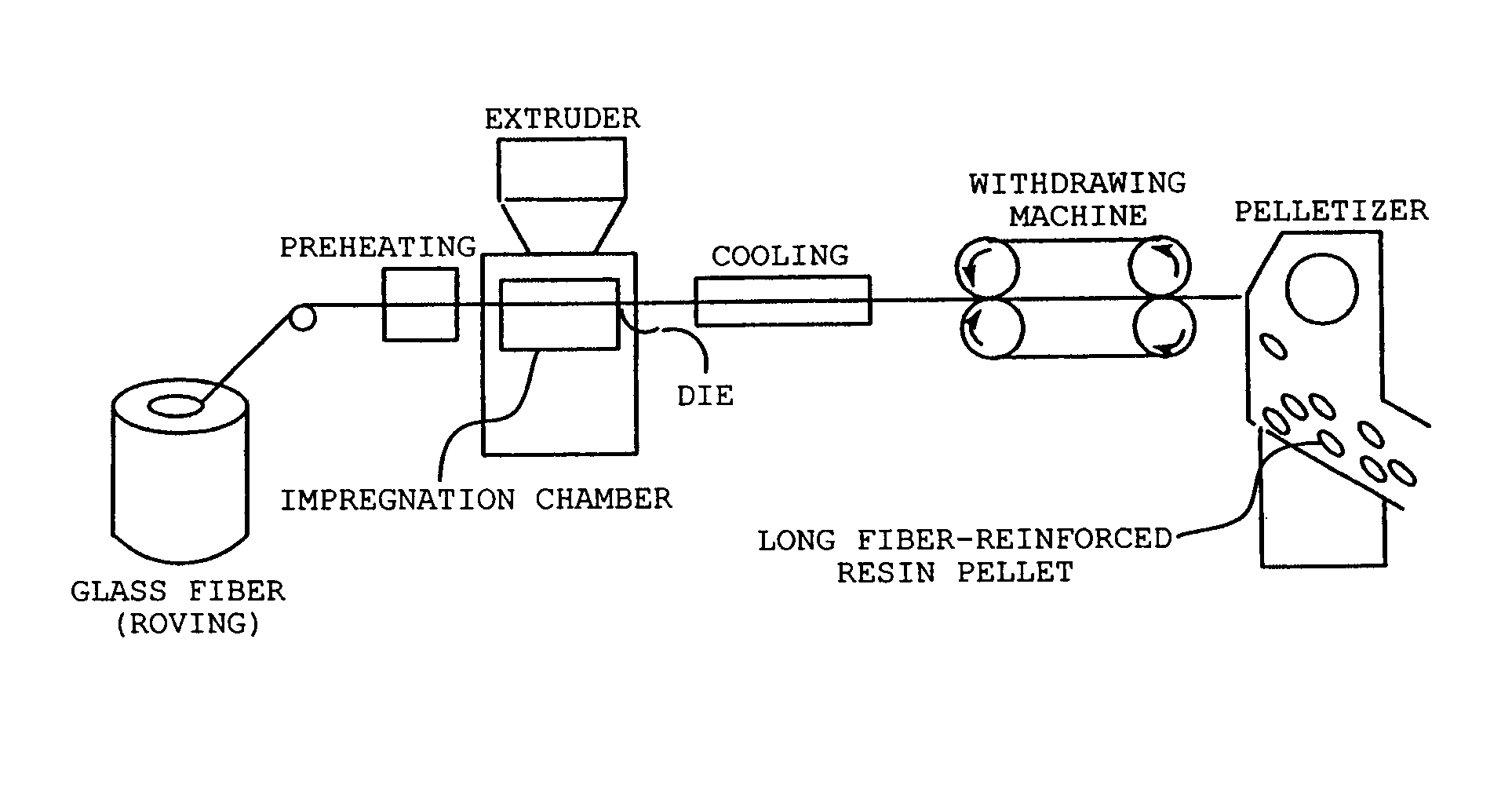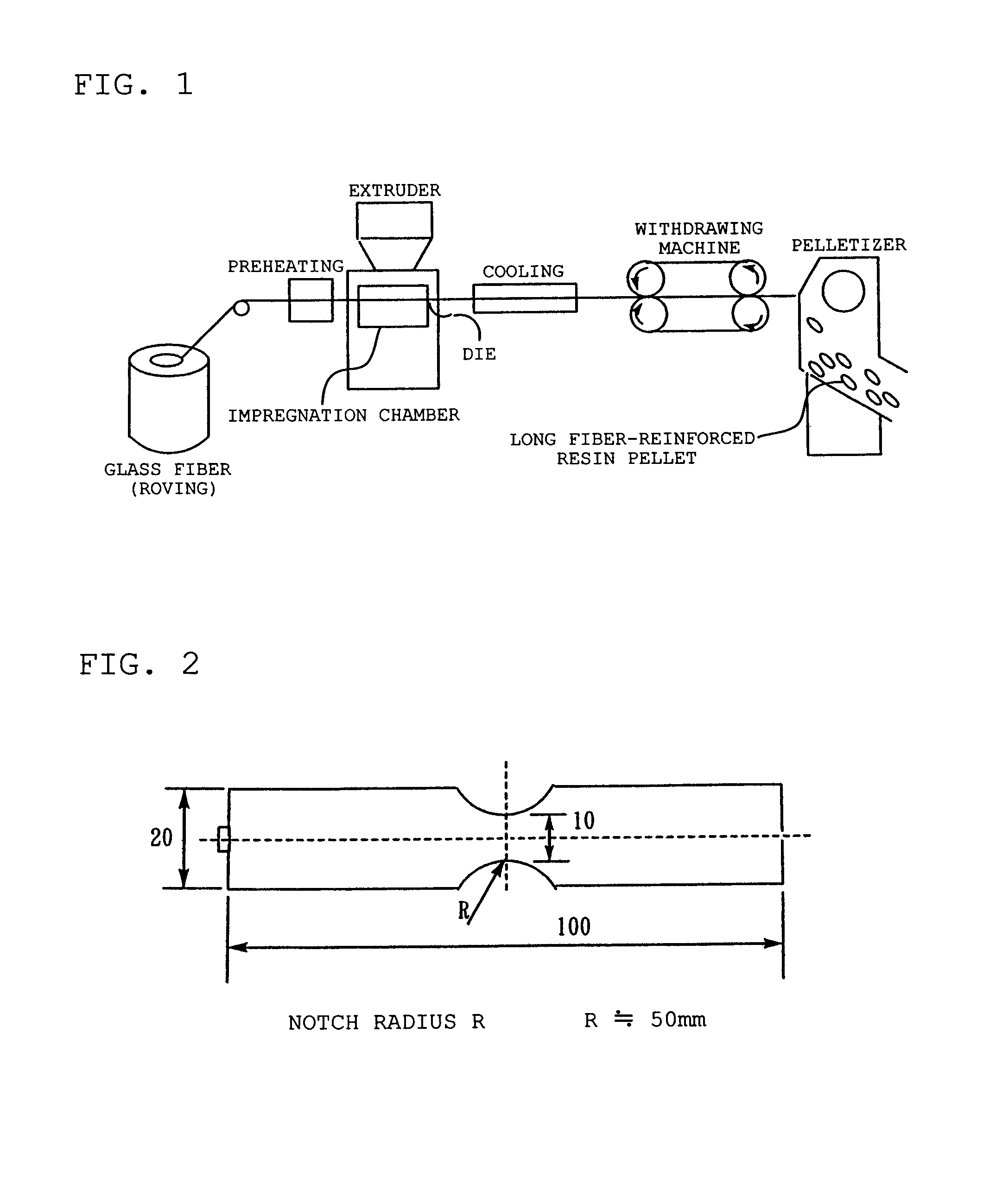Modified polyolefin resin for glass fiber treatment, surface-treated glass fiber, and fiber-reinforced polyolefin resin
a technology of glass fiber and polyolefin, which is applied in the direction of synthetic resin layered products, natural mineral layered products, textiles and paper, etc., can solve the problems of resin likely to be damaged, adverse effects are increased in comparison, and affect the fatigue strength of oscillation, so as to suppress the breakage of glass fibers and facilitate hand.
- Summary
- Abstract
- Description
- Claims
- Application Information
AI Technical Summary
Benefits of technology
Problems solved by technology
Method used
Image
Examples
production example 1
Acid-Modified Polypropylene-Based Resin for Glass Fiber Treatment
(1) Production of Maleic Acid-Modified Polypropylene (EM)
(1-1) Modification Method-1: Melting Method (EM-1 to EM-9, EM-11, and EM-12)
[0166]As shown in Table 2, polypropylene, maleic acid, and an organic peroxide were put in a twin-screw extruder provided with a vent. The resulting mixture was subjected to melt kneading under predetermined conditions to produce maleic acid-modified polypropylene.
[0167]Components extractable with boiling methyl ethyl ketone contained in the resulting maleic acid-modified polypropylene were removed by the following purification method or washing method.
(1-2) Purification Method (EM-1 to EM-8)
[0168]The maleic acid-modified polypropylene obtained above was heated (around 130° C.) in paraxylene with stirring to completely dissolve the resin. The resulting solution was added to methyl ethyl ketone to effect reprecipitatation. After filtration, the product was vacuum-dried (at 130° C. for six ...
production example 2
Production of Surface-Treated Glass Fiber (GFEM)
[0191]E-glass fibers (specific gravity: 2.55 g / cm3) with a diameter of 17 μm were treated with a sizing agent containing the maleic acid-modified polypropylene for glass fiber treatment obtained in Production Example 1 and a silane coupling agent, and dried by heating to obtain a roving.
[0192]
TABLE 4Production of surface-treated glass fiberSizing agentAmount ofSilaneSurfaceEM adhering tocouplingtreatment resinRatiotreated glass fibersagent (CP)(EM)EM / CP(mass %)GFEM-1CP-1EM-160.40GFEM-2CP-1EM-160.40GFEM-3CP-2EM-160.40GFEM-4CP-1EM-260.40GFEM-5CP-1EM-360.40GFEM-6CP-1EM-460.40GFEM-7CP-1EM-560.40GFEM-8CP-1EM-160.40GFEM-9CP-1EM-160.40GFEM-10CP-1EM-160.40GFEM-11CP-1EM-160.40GFEM-12CP-1EM-160.40GFEM-13CP-1EM-160.35GFEM-14CP-1EM-160.30GFEM-15CP-1EM-180.40GFEM-16CP-1EM-660.40GFEM-17CP-1EM-760.40GFEM-18CP-1EM-860.40GFEM-19CP-1EM-960.40GFEM-20CP-1EM-1060.40GFEM-21CP-1EM-1160.40GFEM-26CP-1EM-1260.40GFEM-27CP-1EM-1360.40GFEM-28CP-1EM-1360.40GFEM-29C...
production example 3
Production of Long Fiber-Reinforced Polypropylene-Based Resin Pellets (GFMB)
[0195]As shown in Table 5, long fiber-reinforced polypropylene-based resin pellets with a pellet length of 8 mm and an average pellet diameter (diameter) of 2.1 mm were produced using the surface-treated glass fibers prepared in Production Example 2 using a production apparatus shown in FIG. 1 under the following conditions.
Withdrawing rate: 25 m / min
Preheating temperature: 200° C.
Resin temperature: 260° C.
Cooling temperature: 35° C.
Die diameter: 2.3
[0196]
TABLE 5Production of long fiber-reinforced polypropylene-basedresin pelletsMixing ratio (mass %)Surface-treatedModifiedglass fiberPolypropylenepolypropyleneGFMB-1GFEM-150PP-147MPP-13GFMB-2GFEM-250PP-247MPP-13GFMB-3GFEM-350PP-247MPP-13GFMB-4GFEM-450PP-147MPP-13GFMB-5GFEM-550PP-147MPP-13GFMB-6GFEM-650PP-147MPP-13GFMB-7GFEM-750PP-147MPP-13GFMB-8GFEM-850PP-148MPP-12GFMB-9GFEM-950PP-147MPP-23GFMB-10GFEM-1050PP-147MPP-33GFMB-11GFEM-1150PP-147MPP-43GFMB-12GFEM-1250...
PUM
| Property | Measurement | Unit |
|---|---|---|
| diameter | aaaaa | aaaaa |
| fatigue strength | aaaaa | aaaaa |
| mass % | aaaaa | aaaaa |
Abstract
Description
Claims
Application Information
 Login to View More
Login to View More - R&D
- Intellectual Property
- Life Sciences
- Materials
- Tech Scout
- Unparalleled Data Quality
- Higher Quality Content
- 60% Fewer Hallucinations
Browse by: Latest US Patents, China's latest patents, Technical Efficacy Thesaurus, Application Domain, Technology Topic, Popular Technical Reports.
© 2025 PatSnap. All rights reserved.Legal|Privacy policy|Modern Slavery Act Transparency Statement|Sitemap|About US| Contact US: help@patsnap.com



